Amazon Inc.: Customer Value Management, Segmentation & CLV Impact
VerifiedAdded on 2024/04/26
|16
|4017
|475
Report
AI Summary
This report provides a detailed analysis of customer value management at Amazon Inc., focusing on customer lifetime value (CLV) and market segmentation. It identifies the components for calculating CLV, including customer retention rate, customer acquisition cost, customer profit, and churn rate, demonstrating their impact with calculations based on provided data. The report evaluates the benefits of CLV for Amazon, such as improved customer relationship management and optimized marketing investments. It also explores factors influencing CLV and examines market segmentation strategies applicable to Amazon's customer base, along with B2B and B2C decision-making models, highlighting opportunities for customer value creation. The report concludes by emphasizing the importance of these strategies for enhancing customer loyalty and long-term profitability.
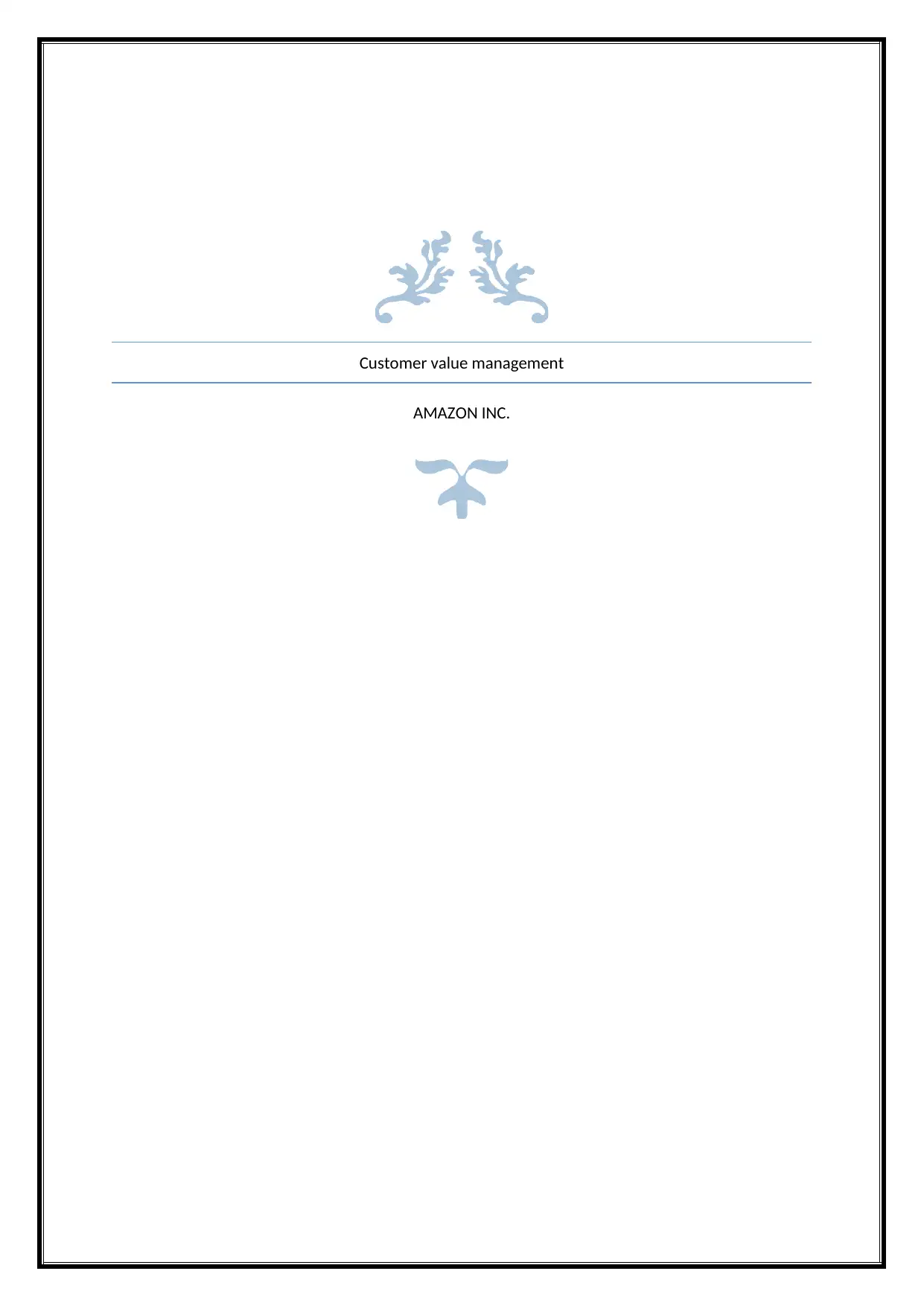
Customer value management
AMAZON INC.
AMAZON INC.
Paraphrase This Document
Need a fresh take? Get an instant paraphrase of this document with our AI Paraphraser
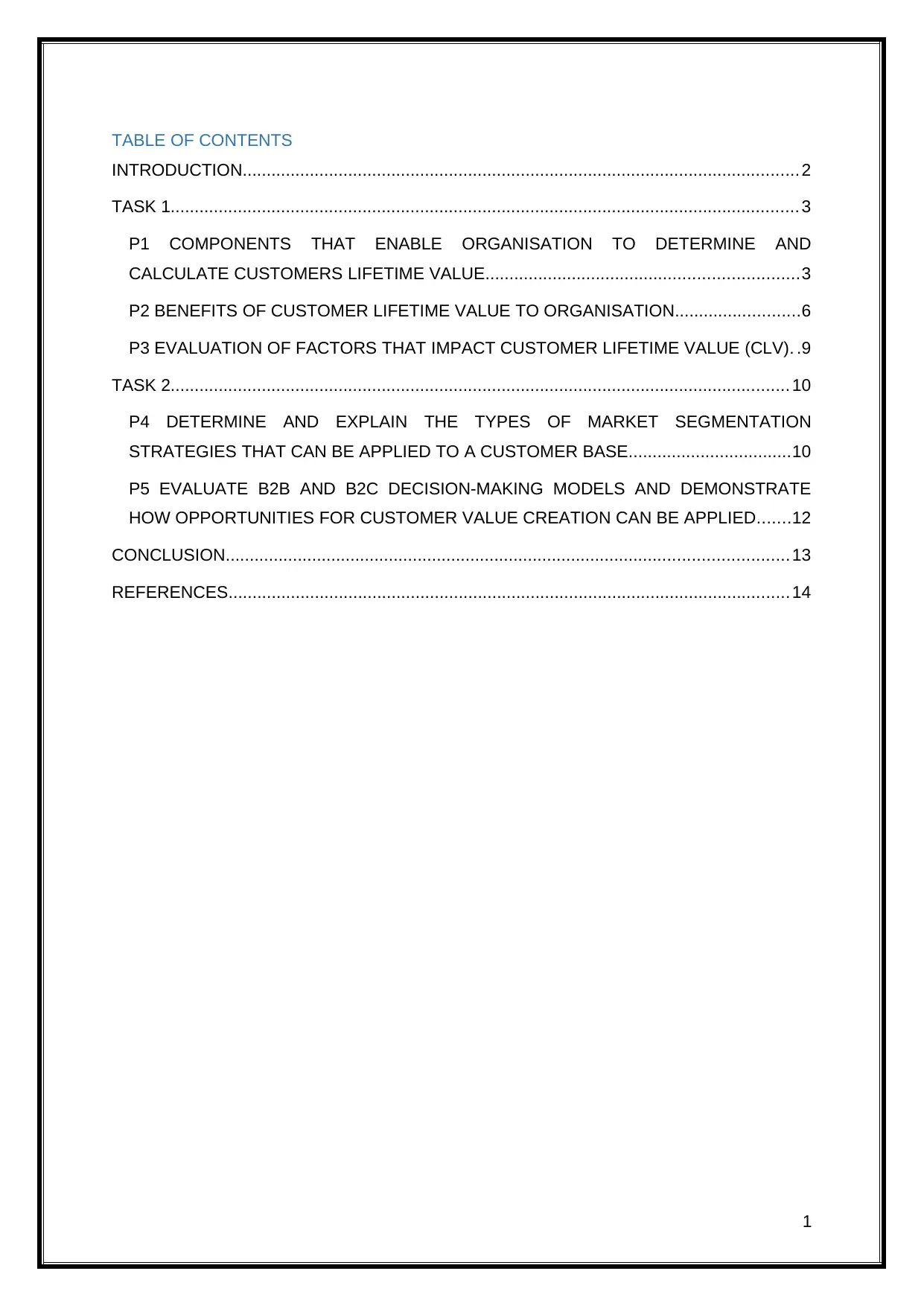
TABLE OF CONTENTS
INTRODUCTION.................................................................................................................... 2
TASK 1................................................................................................................................... 3
P1 COMPONENTS THAT ENABLE ORGANISATION TO DETERMINE AND
CALCULATE CUSTOMERS LIFETIME VALUE.................................................................3
P2 BENEFITS OF CUSTOMER LIFETIME VALUE TO ORGANISATION..........................6
P3 EVALUATION OF FACTORS THAT IMPACT CUSTOMER LIFETIME VALUE (CLV). .9
TASK 2................................................................................................................................. 10
P4 DETERMINE AND EXPLAIN THE TYPES OF MARKET SEGMENTATION
STRATEGIES THAT CAN BE APPLIED TO A CUSTOMER BASE..................................10
P5 EVALUATE B2B AND B2C DECISION-MAKING MODELS AND DEMONSTRATE
HOW OPPORTUNITIES FOR CUSTOMER VALUE CREATION CAN BE APPLIED.......12
CONCLUSION..................................................................................................................... 13
REFERENCES..................................................................................................................... 14
1
INTRODUCTION.................................................................................................................... 2
TASK 1................................................................................................................................... 3
P1 COMPONENTS THAT ENABLE ORGANISATION TO DETERMINE AND
CALCULATE CUSTOMERS LIFETIME VALUE.................................................................3
P2 BENEFITS OF CUSTOMER LIFETIME VALUE TO ORGANISATION..........................6
P3 EVALUATION OF FACTORS THAT IMPACT CUSTOMER LIFETIME VALUE (CLV). .9
TASK 2................................................................................................................................. 10
P4 DETERMINE AND EXPLAIN THE TYPES OF MARKET SEGMENTATION
STRATEGIES THAT CAN BE APPLIED TO A CUSTOMER BASE..................................10
P5 EVALUATE B2B AND B2C DECISION-MAKING MODELS AND DEMONSTRATE
HOW OPPORTUNITIES FOR CUSTOMER VALUE CREATION CAN BE APPLIED.......12
CONCLUSION..................................................................................................................... 13
REFERENCES..................................................................................................................... 14
1
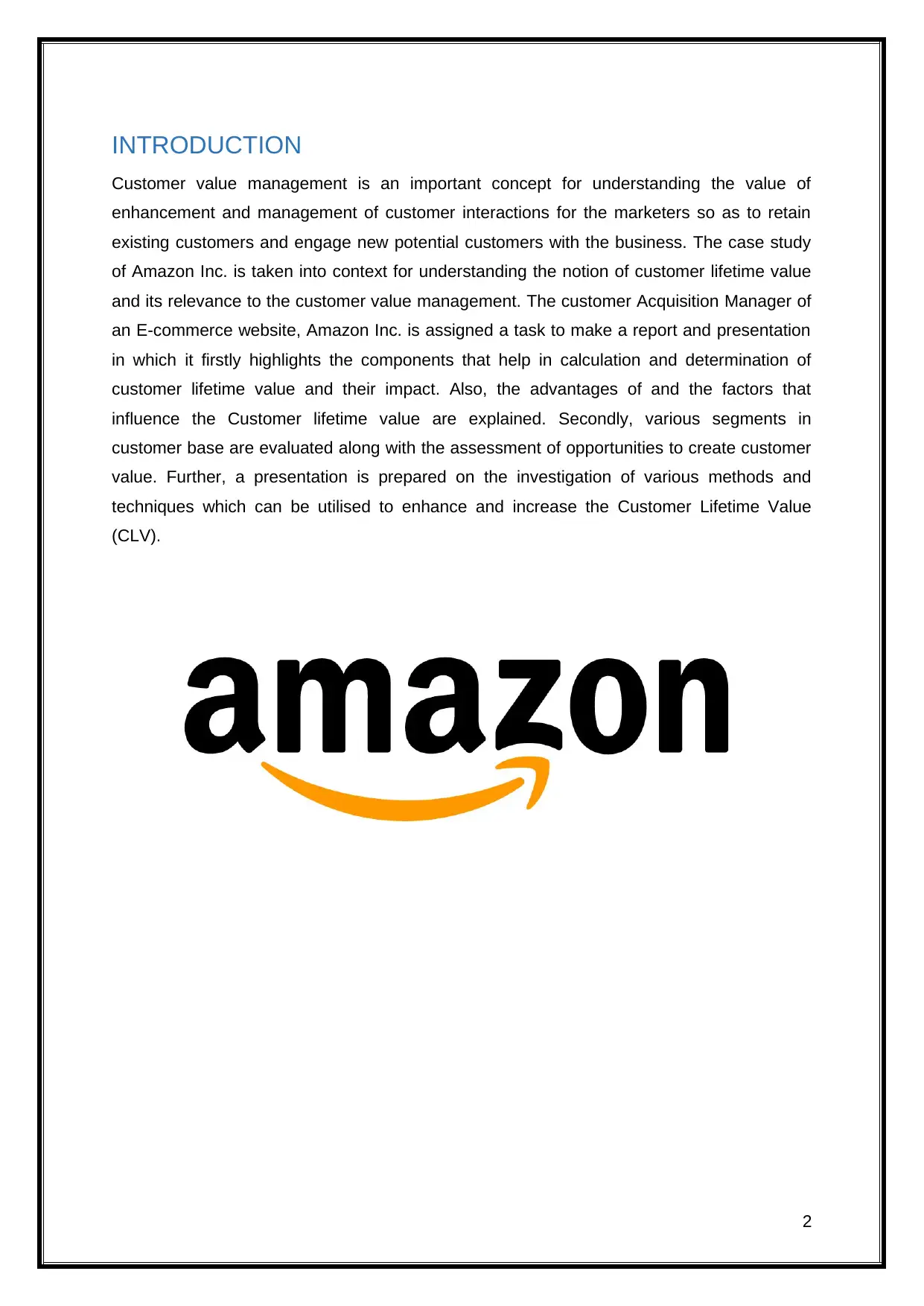
INTRODUCTION
Customer value management is an important concept for understanding the value of
enhancement and management of customer interactions for the marketers so as to retain
existing customers and engage new potential customers with the business. The case study
of Amazon Inc. is taken into context for understanding the notion of customer lifetime value
and its relevance to the customer value management. The customer Acquisition Manager of
an E-commerce website, Amazon Inc. is assigned a task to make a report and presentation
in which it firstly highlights the components that help in calculation and determination of
customer lifetime value and their impact. Also, the advantages of and the factors that
influence the Customer lifetime value are explained. Secondly, various segments in
customer base are evaluated along with the assessment of opportunities to create customer
value. Further, a presentation is prepared on the investigation of various methods and
techniques which can be utilised to enhance and increase the Customer Lifetime Value
(CLV).
2
Customer value management is an important concept for understanding the value of
enhancement and management of customer interactions for the marketers so as to retain
existing customers and engage new potential customers with the business. The case study
of Amazon Inc. is taken into context for understanding the notion of customer lifetime value
and its relevance to the customer value management. The customer Acquisition Manager of
an E-commerce website, Amazon Inc. is assigned a task to make a report and presentation
in which it firstly highlights the components that help in calculation and determination of
customer lifetime value and their impact. Also, the advantages of and the factors that
influence the Customer lifetime value are explained. Secondly, various segments in
customer base are evaluated along with the assessment of opportunities to create customer
value. Further, a presentation is prepared on the investigation of various methods and
techniques which can be utilised to enhance and increase the Customer Lifetime Value
(CLV).
2
⊘ This is a preview!⊘
Do you want full access?
Subscribe today to unlock all pages.

Trusted by 1+ million students worldwide
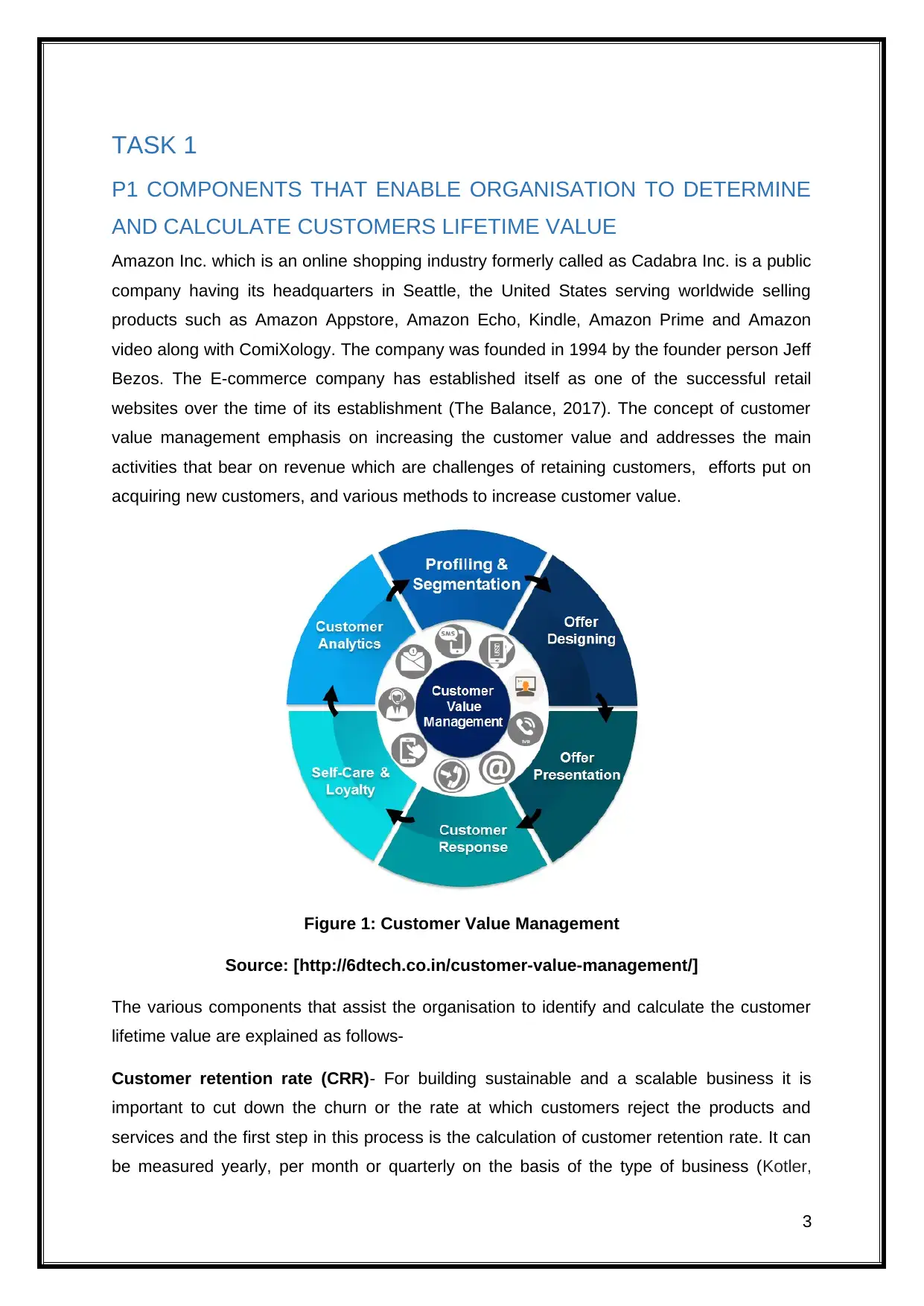
TASK 1
P1 COMPONENTS THAT ENABLE ORGANISATION TO DETERMINE
AND CALCULATE CUSTOMERS LIFETIME VALUE
Amazon Inc. which is an online shopping industry formerly called as Cadabra Inc. is a public
company having its headquarters in Seattle, the United States serving worldwide selling
products such as Amazon Appstore, Amazon Echo, Kindle, Amazon Prime and Amazon
video along with ComiXology. The company was founded in 1994 by the founder person Jeff
Bezos. The E-commerce company has established itself as one of the successful retail
websites over the time of its establishment (The Balance, 2017). The concept of customer
value management emphasis on increasing the customer value and addresses the main
activities that bear on revenue which are challenges of retaining customers, efforts put on
acquiring new customers, and various methods to increase customer value.
Figure 1: Customer Value Management
Source: [http://6dtech.co.in/customer-value-management/]
The various components that assist the organisation to identify and calculate the customer
lifetime value are explained as follows-
Customer retention rate (CRR)- For building sustainable and a scalable business it is
important to cut down the churn or the rate at which customers reject the products and
services and the first step in this process is the calculation of customer retention rate. It can
be measured yearly, per month or quarterly on the basis of the type of business (Kotler,
3
P1 COMPONENTS THAT ENABLE ORGANISATION TO DETERMINE
AND CALCULATE CUSTOMERS LIFETIME VALUE
Amazon Inc. which is an online shopping industry formerly called as Cadabra Inc. is a public
company having its headquarters in Seattle, the United States serving worldwide selling
products such as Amazon Appstore, Amazon Echo, Kindle, Amazon Prime and Amazon
video along with ComiXology. The company was founded in 1994 by the founder person Jeff
Bezos. The E-commerce company has established itself as one of the successful retail
websites over the time of its establishment (The Balance, 2017). The concept of customer
value management emphasis on increasing the customer value and addresses the main
activities that bear on revenue which are challenges of retaining customers, efforts put on
acquiring new customers, and various methods to increase customer value.
Figure 1: Customer Value Management
Source: [http://6dtech.co.in/customer-value-management/]
The various components that assist the organisation to identify and calculate the customer
lifetime value are explained as follows-
Customer retention rate (CRR)- For building sustainable and a scalable business it is
important to cut down the churn or the rate at which customers reject the products and
services and the first step in this process is the calculation of customer retention rate. It can
be measured yearly, per month or quarterly on the basis of the type of business (Kotler,
3
Paraphrase This Document
Need a fresh take? Get an instant paraphrase of this document with our AI Paraphraser
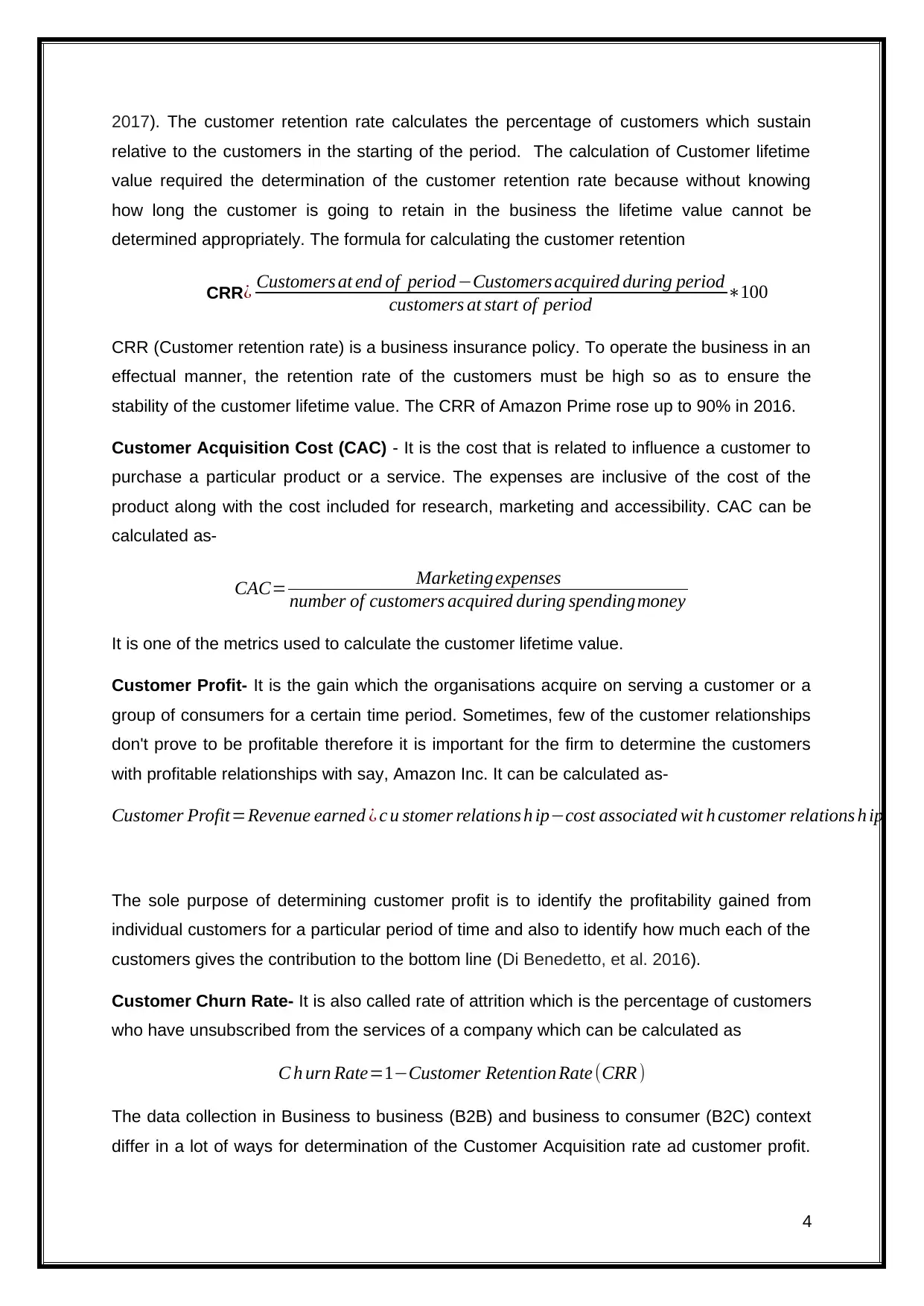
2017). The customer retention rate calculates the percentage of customers which sustain
relative to the customers in the starting of the period. The calculation of Customer lifetime
value required the determination of the customer retention rate because without knowing
how long the customer is going to retain in the business the lifetime value cannot be
determined appropriately. The formula for calculating the customer retention
CRR¿ Customers at end of period−Customers acquired during period
customers at start of period ∗100
CRR (Customer retention rate) is a business insurance policy. To operate the business in an
effectual manner, the retention rate of the customers must be high so as to ensure the
stability of the customer lifetime value. The CRR of Amazon Prime rose up to 90% in 2016.
Customer Acquisition Cost (CAC) - It is the cost that is related to influence a customer to
purchase a particular product or a service. The expenses are inclusive of the cost of the
product along with the cost included for research, marketing and accessibility. CAC can be
calculated as-
CAC= Marketing expenses
number of customers acquired during spendingmoney
It is one of the metrics used to calculate the customer lifetime value.
Customer Profit- It is the gain which the organisations acquire on serving a customer or a
group of consumers for a certain time period. Sometimes, few of the customer relationships
don't prove to be profitable therefore it is important for the firm to determine the customers
with profitable relationships with say, Amazon Inc. It can be calculated as-
Customer Profit=Revenue earned ¿ c u stomer relations h ip−cost associated wit h customer relations h ip
The sole purpose of determining customer profit is to identify the profitability gained from
individual customers for a particular period of time and also to identify how much each of the
customers gives the contribution to the bottom line (Di Benedetto, et al. 2016).
Customer Churn Rate- It is also called rate of attrition which is the percentage of customers
who have unsubscribed from the services of a company which can be calculated as
C h urn Rate=1−Customer Retention Rate (CRR )
The data collection in Business to business (B2B) and business to consumer (B2C) context
differ in a lot of ways for determination of the Customer Acquisition rate ad customer profit.
4
relative to the customers in the starting of the period. The calculation of Customer lifetime
value required the determination of the customer retention rate because without knowing
how long the customer is going to retain in the business the lifetime value cannot be
determined appropriately. The formula for calculating the customer retention
CRR¿ Customers at end of period−Customers acquired during period
customers at start of period ∗100
CRR (Customer retention rate) is a business insurance policy. To operate the business in an
effectual manner, the retention rate of the customers must be high so as to ensure the
stability of the customer lifetime value. The CRR of Amazon Prime rose up to 90% in 2016.
Customer Acquisition Cost (CAC) - It is the cost that is related to influence a customer to
purchase a particular product or a service. The expenses are inclusive of the cost of the
product along with the cost included for research, marketing and accessibility. CAC can be
calculated as-
CAC= Marketing expenses
number of customers acquired during spendingmoney
It is one of the metrics used to calculate the customer lifetime value.
Customer Profit- It is the gain which the organisations acquire on serving a customer or a
group of consumers for a certain time period. Sometimes, few of the customer relationships
don't prove to be profitable therefore it is important for the firm to determine the customers
with profitable relationships with say, Amazon Inc. It can be calculated as-
Customer Profit=Revenue earned ¿ c u stomer relations h ip−cost associated wit h customer relations h ip
The sole purpose of determining customer profit is to identify the profitability gained from
individual customers for a particular period of time and also to identify how much each of the
customers gives the contribution to the bottom line (Di Benedetto, et al. 2016).
Customer Churn Rate- It is also called rate of attrition which is the percentage of customers
who have unsubscribed from the services of a company which can be calculated as
C h urn Rate=1−Customer Retention Rate (CRR )
The data collection in Business to business (B2B) and business to consumer (B2C) context
differ in a lot of ways for determination of the Customer Acquisition rate ad customer profit.
4

In B2B the data collected is valuable but not totally reliable but in B2C the data which is
collected is highly reliable.
5
collected is highly reliable.
5
⊘ This is a preview!⊘
Do you want full access?
Subscribe today to unlock all pages.

Trusted by 1+ million students worldwide
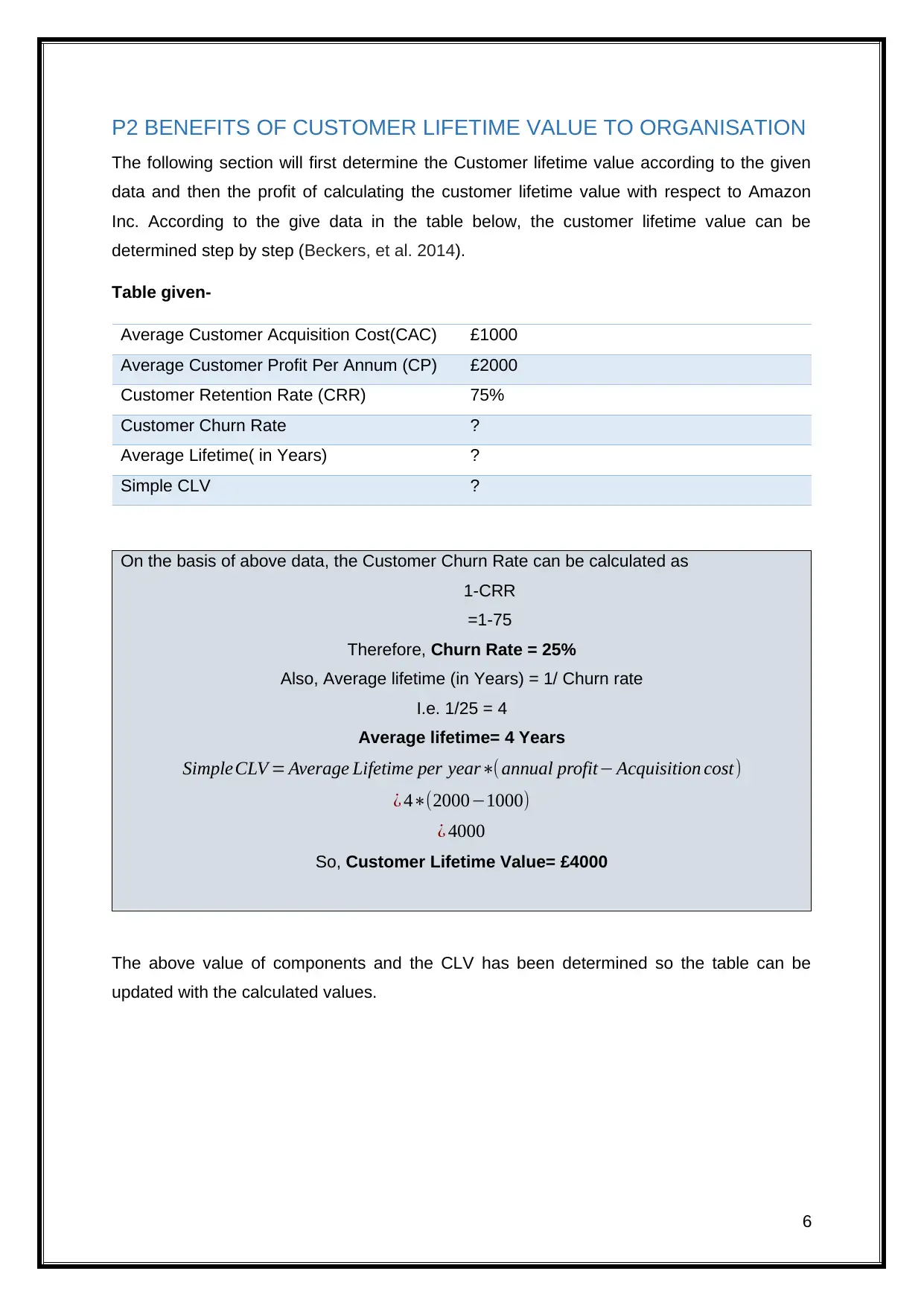
P2 BENEFITS OF CUSTOMER LIFETIME VALUE TO ORGANISATION
The following section will first determine the Customer lifetime value according to the given
data and then the profit of calculating the customer lifetime value with respect to Amazon
Inc. According to the give data in the table below, the customer lifetime value can be
determined step by step (Beckers, et al. 2014).
Table given-
Average Customer Acquisition Cost(CAC) £1000
Average Customer Profit Per Annum (CP) £2000
Customer Retention Rate (CRR) 75%
Customer Churn Rate ?
Average Lifetime( in Years) ?
Simple CLV ?
On the basis of above data, the Customer Churn Rate can be calculated as
1-CRR
=1-75
Therefore, Churn Rate = 25%
Also, Average lifetime (in Years) = 1/ Churn rate
I.e. 1/25 = 4
Average lifetime= 4 Years
SimpleCLV = Average Lifetime per year∗( annual profit− Acquisition cost)
¿ 4∗(2000−1000)
¿ 4000
So, Customer Lifetime Value= £4000
The above value of components and the CLV has been determined so the table can be
updated with the calculated values.
6
The following section will first determine the Customer lifetime value according to the given
data and then the profit of calculating the customer lifetime value with respect to Amazon
Inc. According to the give data in the table below, the customer lifetime value can be
determined step by step (Beckers, et al. 2014).
Table given-
Average Customer Acquisition Cost(CAC) £1000
Average Customer Profit Per Annum (CP) £2000
Customer Retention Rate (CRR) 75%
Customer Churn Rate ?
Average Lifetime( in Years) ?
Simple CLV ?
On the basis of above data, the Customer Churn Rate can be calculated as
1-CRR
=1-75
Therefore, Churn Rate = 25%
Also, Average lifetime (in Years) = 1/ Churn rate
I.e. 1/25 = 4
Average lifetime= 4 Years
SimpleCLV = Average Lifetime per year∗( annual profit− Acquisition cost)
¿ 4∗(2000−1000)
¿ 4000
So, Customer Lifetime Value= £4000
The above value of components and the CLV has been determined so the table can be
updated with the calculated values.
6
Paraphrase This Document
Need a fresh take? Get an instant paraphrase of this document with our AI Paraphraser
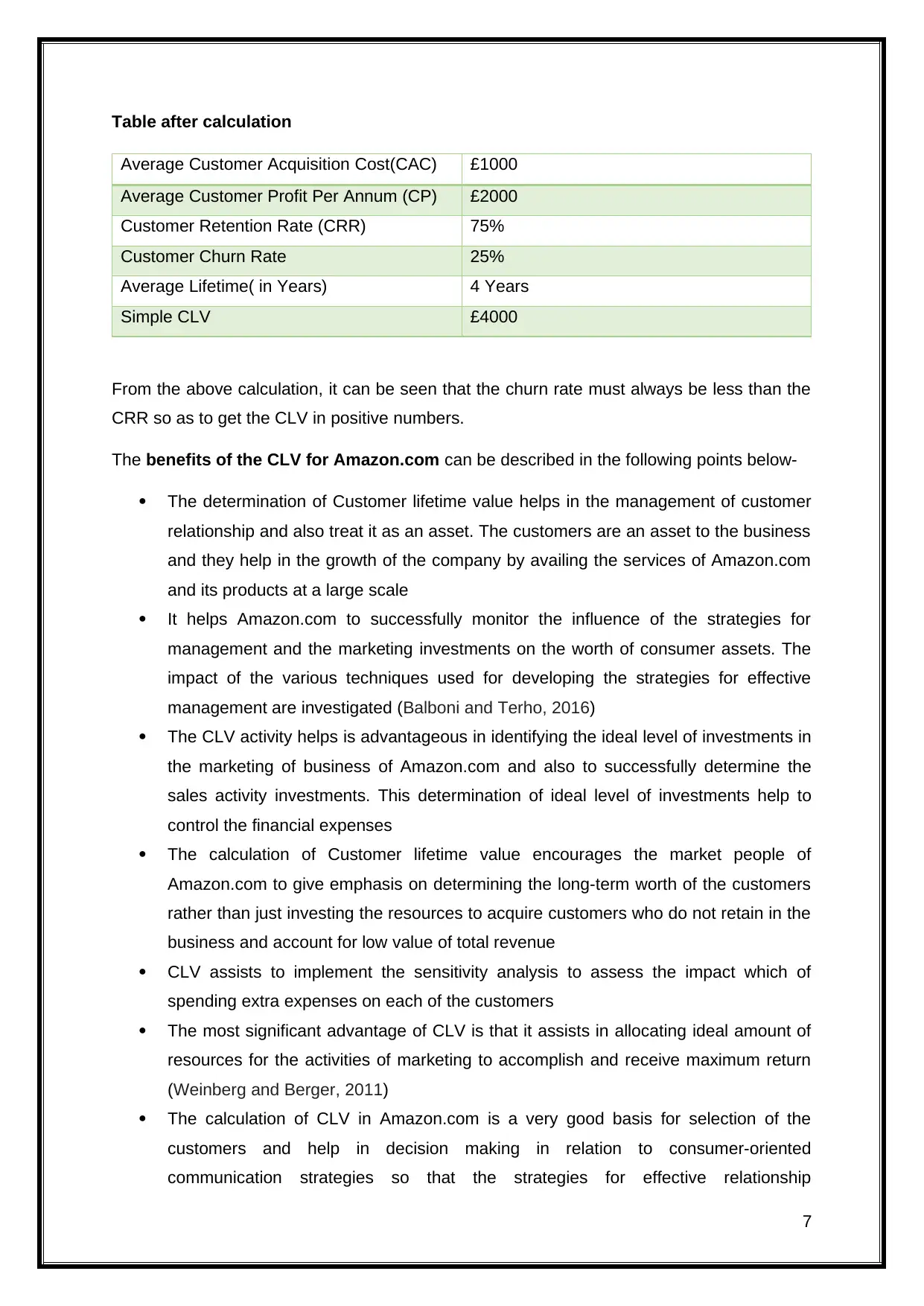
Table after calculation
Average Customer Acquisition Cost(CAC) £1000
Average Customer Profit Per Annum (CP) £2000
Customer Retention Rate (CRR) 75%
Customer Churn Rate 25%
Average Lifetime( in Years) 4 Years
Simple CLV £4000
From the above calculation, it can be seen that the churn rate must always be less than the
CRR so as to get the CLV in positive numbers.
The benefits of the CLV for Amazon.com can be described in the following points below-
The determination of Customer lifetime value helps in the management of customer
relationship and also treat it as an asset. The customers are an asset to the business
and they help in the growth of the company by availing the services of Amazon.com
and its products at a large scale
It helps Amazon.com to successfully monitor the influence of the strategies for
management and the marketing investments on the worth of consumer assets. The
impact of the various techniques used for developing the strategies for effective
management are investigated (Balboni and Terho, 2016)
The CLV activity helps is advantageous in identifying the ideal level of investments in
the marketing of business of Amazon.com and also to successfully determine the
sales activity investments. This determination of ideal level of investments help to
control the financial expenses
The calculation of Customer lifetime value encourages the market people of
Amazon.com to give emphasis on determining the long-term worth of the customers
rather than just investing the resources to acquire customers who do not retain in the
business and account for low value of total revenue
CLV assists to implement the sensitivity analysis to assess the impact which of
spending extra expenses on each of the customers
The most significant advantage of CLV is that it assists in allocating ideal amount of
resources for the activities of marketing to accomplish and receive maximum return
(Weinberg and Berger, 2011)
The calculation of CLV in Amazon.com is a very good basis for selection of the
customers and help in decision making in relation to consumer-oriented
communication strategies so that the strategies for effective relationship
7
Average Customer Acquisition Cost(CAC) £1000
Average Customer Profit Per Annum (CP) £2000
Customer Retention Rate (CRR) 75%
Customer Churn Rate 25%
Average Lifetime( in Years) 4 Years
Simple CLV £4000
From the above calculation, it can be seen that the churn rate must always be less than the
CRR so as to get the CLV in positive numbers.
The benefits of the CLV for Amazon.com can be described in the following points below-
The determination of Customer lifetime value helps in the management of customer
relationship and also treat it as an asset. The customers are an asset to the business
and they help in the growth of the company by availing the services of Amazon.com
and its products at a large scale
It helps Amazon.com to successfully monitor the influence of the strategies for
management and the marketing investments on the worth of consumer assets. The
impact of the various techniques used for developing the strategies for effective
management are investigated (Balboni and Terho, 2016)
The CLV activity helps is advantageous in identifying the ideal level of investments in
the marketing of business of Amazon.com and also to successfully determine the
sales activity investments. This determination of ideal level of investments help to
control the financial expenses
The calculation of Customer lifetime value encourages the market people of
Amazon.com to give emphasis on determining the long-term worth of the customers
rather than just investing the resources to acquire customers who do not retain in the
business and account for low value of total revenue
CLV assists to implement the sensitivity analysis to assess the impact which of
spending extra expenses on each of the customers
The most significant advantage of CLV is that it assists in allocating ideal amount of
resources for the activities of marketing to accomplish and receive maximum return
(Weinberg and Berger, 2011)
The calculation of CLV in Amazon.com is a very good basis for selection of the
customers and help in decision making in relation to consumer-oriented
communication strategies so that the strategies for effective relationship
7
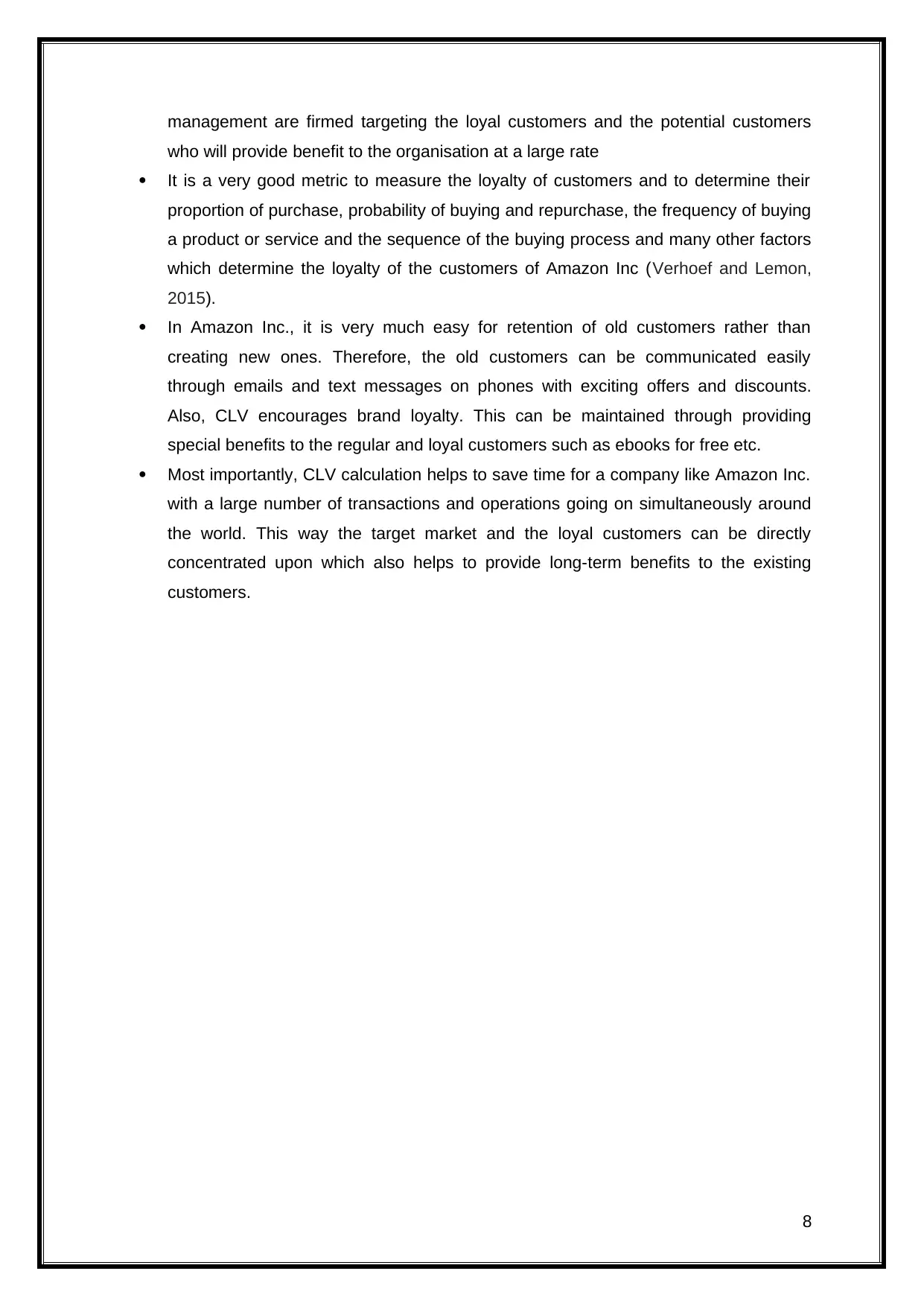
management are firmed targeting the loyal customers and the potential customers
who will provide benefit to the organisation at a large rate
It is a very good metric to measure the loyalty of customers and to determine their
proportion of purchase, probability of buying and repurchase, the frequency of buying
a product or service and the sequence of the buying process and many other factors
which determine the loyalty of the customers of Amazon Inc (Verhoef and Lemon,
2015).
In Amazon Inc., it is very much easy for retention of old customers rather than
creating new ones. Therefore, the old customers can be communicated easily
through emails and text messages on phones with exciting offers and discounts.
Also, CLV encourages brand loyalty. This can be maintained through providing
special benefits to the regular and loyal customers such as ebooks for free etc.
Most importantly, CLV calculation helps to save time for a company like Amazon Inc.
with a large number of transactions and operations going on simultaneously around
the world. This way the target market and the loyal customers can be directly
concentrated upon which also helps to provide long-term benefits to the existing
customers.
8
who will provide benefit to the organisation at a large rate
It is a very good metric to measure the loyalty of customers and to determine their
proportion of purchase, probability of buying and repurchase, the frequency of buying
a product or service and the sequence of the buying process and many other factors
which determine the loyalty of the customers of Amazon Inc (Verhoef and Lemon,
2015).
In Amazon Inc., it is very much easy for retention of old customers rather than
creating new ones. Therefore, the old customers can be communicated easily
through emails and text messages on phones with exciting offers and discounts.
Also, CLV encourages brand loyalty. This can be maintained through providing
special benefits to the regular and loyal customers such as ebooks for free etc.
Most importantly, CLV calculation helps to save time for a company like Amazon Inc.
with a large number of transactions and operations going on simultaneously around
the world. This way the target market and the loyal customers can be directly
concentrated upon which also helps to provide long-term benefits to the existing
customers.
8
⊘ This is a preview!⊘
Do you want full access?
Subscribe today to unlock all pages.

Trusted by 1+ million students worldwide
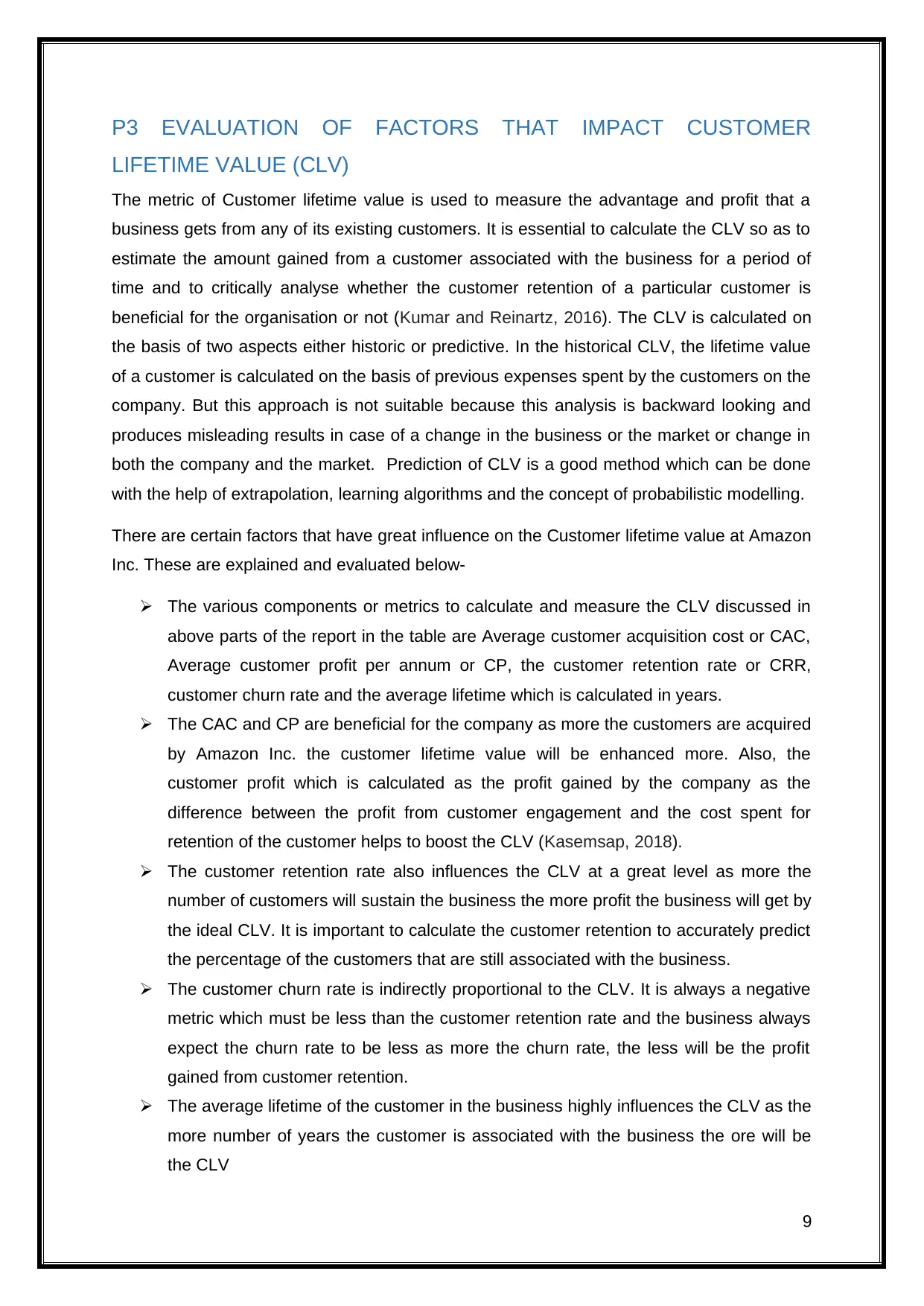
P3 EVALUATION OF FACTORS THAT IMPACT CUSTOMER
LIFETIME VALUE (CLV)
The metric of Customer lifetime value is used to measure the advantage and profit that a
business gets from any of its existing customers. It is essential to calculate the CLV so as to
estimate the amount gained from a customer associated with the business for a period of
time and to critically analyse whether the customer retention of a particular customer is
beneficial for the organisation or not (Kumar and Reinartz, 2016). The CLV is calculated on
the basis of two aspects either historic or predictive. In the historical CLV, the lifetime value
of a customer is calculated on the basis of previous expenses spent by the customers on the
company. But this approach is not suitable because this analysis is backward looking and
produces misleading results in case of a change in the business or the market or change in
both the company and the market. Prediction of CLV is a good method which can be done
with the help of extrapolation, learning algorithms and the concept of probabilistic modelling.
There are certain factors that have great influence on the Customer lifetime value at Amazon
Inc. These are explained and evaluated below-
The various components or metrics to calculate and measure the CLV discussed in
above parts of the report in the table are Average customer acquisition cost or CAC,
Average customer profit per annum or CP, the customer retention rate or CRR,
customer churn rate and the average lifetime which is calculated in years.
The CAC and CP are beneficial for the company as more the customers are acquired
by Amazon Inc. the customer lifetime value will be enhanced more. Also, the
customer profit which is calculated as the profit gained by the company as the
difference between the profit from customer engagement and the cost spent for
retention of the customer helps to boost the CLV (Kasemsap, 2018).
The customer retention rate also influences the CLV at a great level as more the
number of customers will sustain the business the more profit the business will get by
the ideal CLV. It is important to calculate the customer retention to accurately predict
the percentage of the customers that are still associated with the business.
The customer churn rate is indirectly proportional to the CLV. It is always a negative
metric which must be less than the customer retention rate and the business always
expect the churn rate to be less as more the churn rate, the less will be the profit
gained from customer retention.
The average lifetime of the customer in the business highly influences the CLV as the
more number of years the customer is associated with the business the ore will be
the CLV
9
LIFETIME VALUE (CLV)
The metric of Customer lifetime value is used to measure the advantage and profit that a
business gets from any of its existing customers. It is essential to calculate the CLV so as to
estimate the amount gained from a customer associated with the business for a period of
time and to critically analyse whether the customer retention of a particular customer is
beneficial for the organisation or not (Kumar and Reinartz, 2016). The CLV is calculated on
the basis of two aspects either historic or predictive. In the historical CLV, the lifetime value
of a customer is calculated on the basis of previous expenses spent by the customers on the
company. But this approach is not suitable because this analysis is backward looking and
produces misleading results in case of a change in the business or the market or change in
both the company and the market. Prediction of CLV is a good method which can be done
with the help of extrapolation, learning algorithms and the concept of probabilistic modelling.
There are certain factors that have great influence on the Customer lifetime value at Amazon
Inc. These are explained and evaluated below-
The various components or metrics to calculate and measure the CLV discussed in
above parts of the report in the table are Average customer acquisition cost or CAC,
Average customer profit per annum or CP, the customer retention rate or CRR,
customer churn rate and the average lifetime which is calculated in years.
The CAC and CP are beneficial for the company as more the customers are acquired
by Amazon Inc. the customer lifetime value will be enhanced more. Also, the
customer profit which is calculated as the profit gained by the company as the
difference between the profit from customer engagement and the cost spent for
retention of the customer helps to boost the CLV (Kasemsap, 2018).
The customer retention rate also influences the CLV at a great level as more the
number of customers will sustain the business the more profit the business will get by
the ideal CLV. It is important to calculate the customer retention to accurately predict
the percentage of the customers that are still associated with the business.
The customer churn rate is indirectly proportional to the CLV. It is always a negative
metric which must be less than the customer retention rate and the business always
expect the churn rate to be less as more the churn rate, the less will be the profit
gained from customer retention.
The average lifetime of the customer in the business highly influences the CLV as the
more number of years the customer is associated with the business the ore will be
the CLV
9
Paraphrase This Document
Need a fresh take? Get an instant paraphrase of this document with our AI Paraphraser
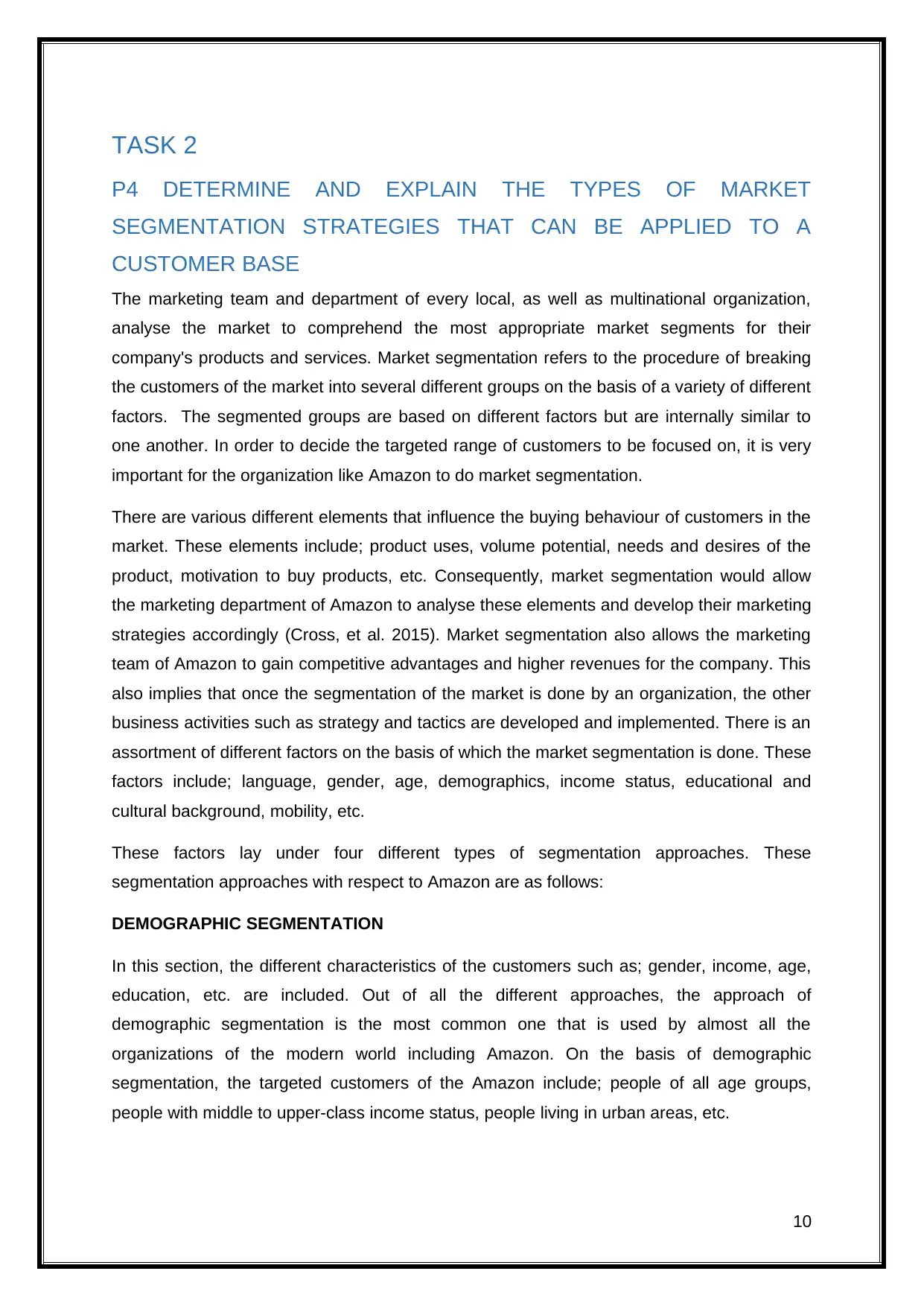
TASK 2
P4 DETERMINE AND EXPLAIN THE TYPES OF MARKET
SEGMENTATION STRATEGIES THAT CAN BE APPLIED TO A
CUSTOMER BASE
The marketing team and department of every local, as well as multinational organization,
analyse the market to comprehend the most appropriate market segments for their
company's products and services. Market segmentation refers to the procedure of breaking
the customers of the market into several different groups on the basis of a variety of different
factors. The segmented groups are based on different factors but are internally similar to
one another. In order to decide the targeted range of customers to be focused on, it is very
important for the organization like Amazon to do market segmentation.
There are various different elements that influence the buying behaviour of customers in the
market. These elements include; product uses, volume potential, needs and desires of the
product, motivation to buy products, etc. Consequently, market segmentation would allow
the marketing department of Amazon to analyse these elements and develop their marketing
strategies accordingly (Cross, et al. 2015). Market segmentation also allows the marketing
team of Amazon to gain competitive advantages and higher revenues for the company. This
also implies that once the segmentation of the market is done by an organization, the other
business activities such as strategy and tactics are developed and implemented. There is an
assortment of different factors on the basis of which the market segmentation is done. These
factors include; language, gender, age, demographics, income status, educational and
cultural background, mobility, etc.
These factors lay under four different types of segmentation approaches. These
segmentation approaches with respect to Amazon are as follows:
DEMOGRAPHIC SEGMENTATION
In this section, the different characteristics of the customers such as; gender, income, age,
education, etc. are included. Out of all the different approaches, the approach of
demographic segmentation is the most common one that is used by almost all the
organizations of the modern world including Amazon. On the basis of demographic
segmentation, the targeted customers of the Amazon include; people of all age groups,
people with middle to upper-class income status, people living in urban areas, etc.
10
P4 DETERMINE AND EXPLAIN THE TYPES OF MARKET
SEGMENTATION STRATEGIES THAT CAN BE APPLIED TO A
CUSTOMER BASE
The marketing team and department of every local, as well as multinational organization,
analyse the market to comprehend the most appropriate market segments for their
company's products and services. Market segmentation refers to the procedure of breaking
the customers of the market into several different groups on the basis of a variety of different
factors. The segmented groups are based on different factors but are internally similar to
one another. In order to decide the targeted range of customers to be focused on, it is very
important for the organization like Amazon to do market segmentation.
There are various different elements that influence the buying behaviour of customers in the
market. These elements include; product uses, volume potential, needs and desires of the
product, motivation to buy products, etc. Consequently, market segmentation would allow
the marketing department of Amazon to analyse these elements and develop their marketing
strategies accordingly (Cross, et al. 2015). Market segmentation also allows the marketing
team of Amazon to gain competitive advantages and higher revenues for the company. This
also implies that once the segmentation of the market is done by an organization, the other
business activities such as strategy and tactics are developed and implemented. There is an
assortment of different factors on the basis of which the market segmentation is done. These
factors include; language, gender, age, demographics, income status, educational and
cultural background, mobility, etc.
These factors lay under four different types of segmentation approaches. These
segmentation approaches with respect to Amazon are as follows:
DEMOGRAPHIC SEGMENTATION
In this section, the different characteristics of the customers such as; gender, income, age,
education, etc. are included. Out of all the different approaches, the approach of
demographic segmentation is the most common one that is used by almost all the
organizations of the modern world including Amazon. On the basis of demographic
segmentation, the targeted customers of the Amazon include; people of all age groups,
people with middle to upper-class income status, people living in urban areas, etc.
10

11
⊘ This is a preview!⊘
Do you want full access?
Subscribe today to unlock all pages.

Trusted by 1+ million students worldwide
1 out of 16
Related Documents
Your All-in-One AI-Powered Toolkit for Academic Success.
+13062052269
info@desklib.com
Available 24*7 on WhatsApp / Email
![[object Object]](/_next/static/media/star-bottom.7253800d.svg)
Unlock your academic potential
Copyright © 2020–2025 A2Z Services. All Rights Reserved. Developed and managed by ZUCOL.





